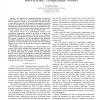Free Online Productivity Tools
i2Speak
i2Symbol
i2OCR
iTex2Img
iWeb2Print
iWeb2Shot
i2Type
iPdf2Split
iPdf2Merge
i2Bopomofo
i2Arabic
i2Style
i2Image
i2PDF
iLatex2Rtf
Sci2ools
94
Voted
INFOCOM
2007
IEEE
2007
IEEE
Achievable Capacity Under the Interference Temperature Model
— The Interference Temperature Model was proposed by the FCC in 2003 as a way to dynamically manage and allocate spectrum resources. It would allow unlicensed radios to sense their current RF environment and transmit in licensed bands, provided their transmission does not raise the interference temperature for that frequency band over the interference temperature limit. It never received much interest because nobody was sure exactly how to use it or how if it would work. This research focuses on a mathematical analysis of the interference temperature model in an effort to examine the relationships between the capacity achieved by the unlicensed network and the interference caused to the licensed network. We develop a model for the RF environment and determine probability distributions governing interference temperature as a function of various elements in the model. We then determine bounds on the amount of interference caused by implementing such a system. We examine model environme...
Communications | INFOCOM 2007 | Interference Temperature | Interference Temperature Limit | Interference Temperature Model |
Related Content
| Added | 03 Jun 2010 |
| Updated | 03 Jun 2010 |
| Type | Conference |
| Year | 2007 |
| Where | INFOCOM |
| Authors | Thomas C. Clancy |
Comments (0)

